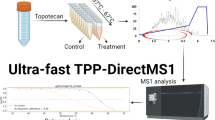Abstract
Quantitative mass spectrometry–based proteomics is highly versatile but not easily multiplexed. Isobaric labeling strategies allow mass spectrometry–based multiplexed proteome quantification; however, ratio distortion owing to protein quantification interference is a common effect. We present a two-proteome model (mixture of human and yeast proteins) in a sixplex isobaric labeling system to fully document the interference effect, and we report that applying triple-stage mass spectrometry (MS3) almost completely eliminates interference.



Similar content being viewed by others
References
Aebersold, R. & Mann, M. Nature 422, 198–207 (2003).
Ross, P.L. et al. Mol. Cell Proteomics 3, 1154–1169 (2004).
Dayon, L. et al. Anal. Chem. 80, 2921–2931 (2008).
Thompson, A. et al. Anal. Chem. 75, 1895–1904 (2003).
Choe, L. et al. Proteomics 7, 3651–3660 (2007).
Bantscheff, M. et al. Mol. Cell Proteomics 7, 1702–1713 (2008).
Karp, N.A. et al. Mol. Cell Proteomics 9, 1885–1897 (2010).
Ow, S.Y. et al. J. Proteome Res. 8, 5347–5355 (2009).
Shirran, S.L. & Botting, C.H. J. Proteomics 73, 1391–1403 (2010).
Villén, J. & Gygi, S.P. Nat. Protoc. 3, 1630–1638 (2008).
Olsen, J.V. et al. Nat. Methods 4, 709–712 (2007).
Elias, J.E. & Gygi, S.P. Nat. Methods 4, 207–214 (2007).
Huttlin, E.L. et al. Cell 143, 1174–1189 (2010).
Beausoleil, S.A. et al. Proc. Natl. Acad. Sci. USA 101, 12130–12135 (2004).
Eng, J.K., McCormack, A.L. & Yates, J.R. III. J. Am. Soc. Mass Spectrom. 5, 976–989 (1994).
Acknowledgements
This work was supported in part by US National Institutes of Health grants (HG3456 and GM67945) to S.P.G.
Author information
Authors and Affiliations
Contributions
L.T., S.P.G. and W.H. designed experiments, analyzed data and wrote the paper. L.T. and W.H. performed experiments. R.R. developed software for data analysis.
Corresponding authors
Ethics declarations
Competing interests
The authors declare no competing financial interests.
Supplementary information
Supplementary Text and Figures
Supplementary Figures 1–6 and Supplementary Table 1 (PDF 831 kb)
Supplementary Data
All yeast and human identification and quantification data. (XLSX 57496 kb)
Rights and permissions
About this article
Cite this article
Ting, L., Rad, R., Gygi, S. et al. MS3 eliminates ratio distortion in isobaric multiplexed quantitative proteomics. Nat Methods 8, 937–940 (2011). https://doi.org/10.1038/nmeth.1714
Received:
Accepted:
Published:
Issue Date:
DOI: https://doi.org/10.1038/nmeth.1714
- Springer Nature America, Inc.
This article is cited by
-
Neuron type-specific proteomics reveals distinct Shank3 proteoforms in iSPNs and dSPNs lead to striatal synaptopathy in Shank3B–/– mice
Molecular Psychiatry (2024)
-
Discovery of WRN inhibitor HRO761 with synthetic lethality in MSI cancers
Nature (2024)
-
Recent advances of small extracellular vesicle biomarkers in breast cancer diagnosis and prognosis
Molecular Cancer (2023)
-
Polarized microtubule remodeling transforms the morphology of reactive microglia and drives cytokine release
Nature Communications (2023)
-
A proteome-wide atlas of drug mechanism of action
Nature Biotechnology (2023)





